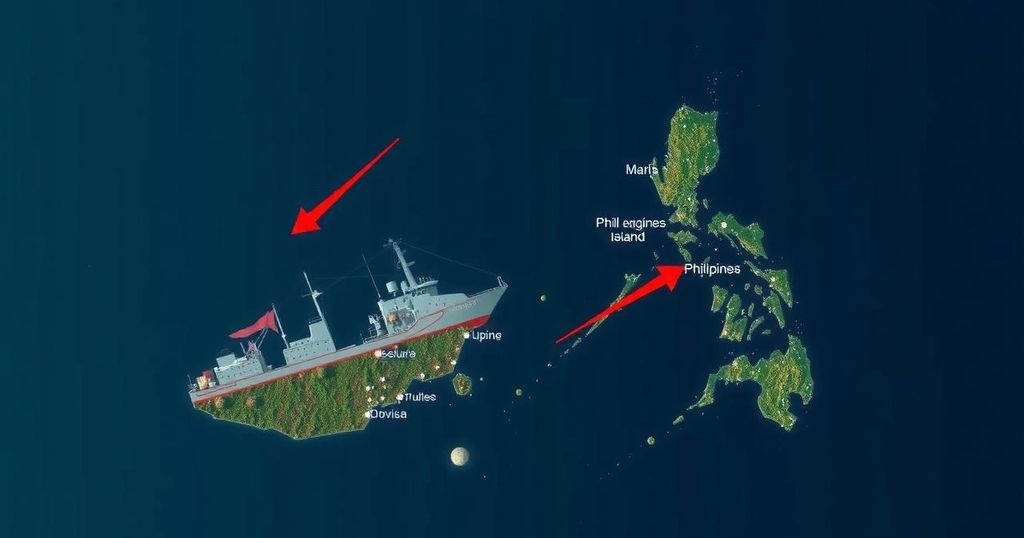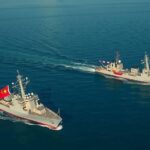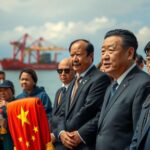Politics
ALFONSO TORRES, ASIA, BEIJING, BRP SIERRA MADRE, CHINA, CHINESE DEFENCE MINISTRY, COAST GUARD, EUROPE, GREG TORODE, KAREN LEMA, MAXAR TECHNOLOGIES, MEXICO, MUTUAL DEFENSE TREATY, NAVY, NORTH AMERICA, PERMANENT COURT OF ARBITRATION, ROY TRINIDAD, SCARBOROUGH, SUBI, SURFING, TERRITORIAL DISPUTE, TERRITORIAL DISPUTES, THITU ISLAND, TRINIDAD, UNITED KINGDOM
Nia Simpson
Build-Up of Chinese Vessels Near Thitu Island: Implications and Insights
Satellite images reveal a substantial presence of Chinese vessels near Thitu Island, a strategic outpost for the Philippines. Philippine officials report that this build-up is not alarming and is typical for the area. Observers note that these vessels could potentially disrupt Philippine efforts to enhance their military establishment on the island and may be testing the Philippines’ reactions amid internal political tensions.
Recent satellite imagery captured by Maxar Technologies has revealed a significant accumulation of Chinese civilian vessels near Thitu Island, a critical outpost for the Philippines in the South China Sea. Despite this build-up, Vice Admiral Alfonso Torres, the chief of the Philippines’ Western Command, assures that there is no immediate cause for concern. He noted that it is common for so-called “maritime militia” vessels to converge in this area, emphasizing that the Philippine Navy is well aware of their presence.
The vessels, predominantly Chinese-registered fishing boats, are believed to work in conjunction with the Chinese coast guard and navy, enhancing China’s assertive stance in contested waters. Rear Admiral Roy Trinidad, the spokesperson for the Philippines Navy, referred to the gathering as an “illegal presence” but reiterated that it does not necessitate alarm.
Thitu Island, known locally as Pag-Asa, is strategically significant for Manila, particularly when monitoring Chinese maritime activities. Previously, a ruling from the Permanent Court of Arbitration invalidated China’s expansive claims in the area on legal grounds. The recent increase in vessels follows a series of confrontations between Chinese and Philippine ships, particularly concerning areas like Scarborough Shoal.
Additionally, regional analysts are paying close attention to the situational dynamics, as the Chinese vessels have recently activated their transponders, allowing for tracking. Some experts suggest that this influx could be intended to gauge the Philippines’ response during a period of internal political strife, marked by tensions within the Philippine government. Moreover, the presence of these vessels could potentially hinder the Philippine construction efforts in Thitu Island, where a new aircraft hangar is expected to be completed soon, enhancing their operational capacity.
The South China Sea remains a focal point of geopolitical tensions, predominantly between China and several Southeast Asian nations, including the Philippines. Notably, Thitu Island serves as a vital military outpost for the Philippines, which consistently faces challenges to its sovereignty from Chinese maritime activities. In 2016, an international tribunal ruled against China’s extensive territorial claims in the region, yet tensions have persisted, exacerbated by frequent encounters between the vessels of the two nations. Recent developments indicate a potential strategy by China to create pressure and distraction while the Philippines bolsters its defenses on Thitu Island.
In summary, the satellite images documenting the accumulation of Chinese vessels near Thitu Island signify a continuation of the complex disputes in the South China Sea. While Philippine military officials maintain that there is no immediate threat, the situation remains precarious, requiring vigilant monitoring. The intersection of maritime activity and domestic political challenges may further complicate the Philippines’ responses to Chinese maneuvers in the region.
Original Source: www.usnews.com








Post Comment